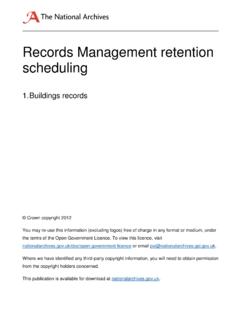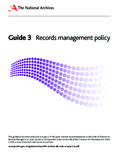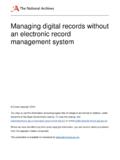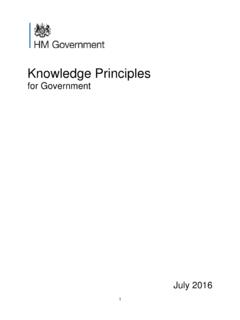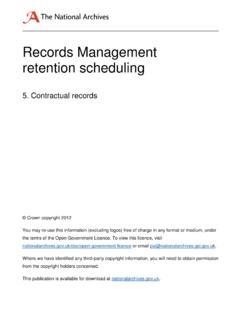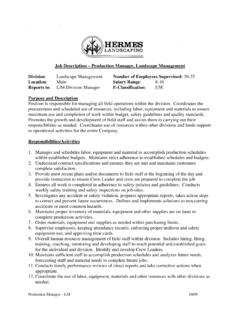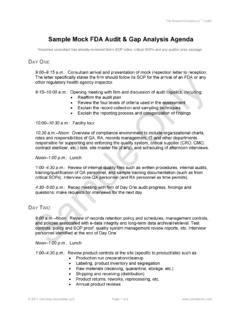Transcription of Records Management retention scheduling 6. Project …
1 Records Management retention scheduling 6. Project Records Crown copyright 2012 You may re-use this information (excluding logos) free of charge in any format or medium, under the terms of the Open Government Licence. To view this licence, visit or email Where we have identified any third-party copyright information, you will need to obtain permission from the copyright holders concerned. This publication is available for download at Records Management retention scheduling 6. Project Records Last updated June 2004 Page 2 of 11 Contents 1 Introduction .. 2 2 Minimum retention periods .. 3 3 scheduling the Records of individual projects .. 4 4 Glossary .. 5 5 Other publications and further information .. 7 Project Records model disposal schedule .. 9 1 Introduction The following guidance is aimed at Departmental record Officers and their staff and also staff in government departments and agencies who have responsibilities for Project Management .
2 It covers Records in all media generated by all kinds of projects, from simple undertakings such as the publication of government reports to large projects such as building construction. This guidance should be read in conjunction with other publications in this series, in particular: Buildings Records retention schedule Accounting Records retention schedule Contractual Records retention schedule A Project is a Management approach designed to bring about a change. It provides a framework bridging the current state of affairs and a planned future. Once achieved, the framework has served its purpose. All projects are finite and the Records that they produce are of minimal business use afterwards. Records Management retention scheduling 6. Project Records Last updated June 2004 Page 3 of 11 2 Minimum retention periods There are many record types common to most projects.
3 Their retention periods are usually determined by legislation or by general Records schedules used throughout government. For example, accounting and other financial Records are largely covered by the Limitation Act 1980. See also Accounting Records retention schedule. Many Records will be unique to a particular Project , such as technical documents, maps or plans. The retention of these Records may be determined by the nature of the Project and also by historical considerations. For example, the documents of a major government building Project such as the Queen Elizabeth II Conference Centre in London are likely to be retained for longer than those for the refurbishment of a government office block. Some Records of major building projects are likely to be worthy of permanent preservation or will need to be retained for the lifetime of the facility.
4 See Buildings Records retention schedule. The most important factors to consider when deciding appropriate retention periods for Project Records are: the significance of the contribution made by the Project to the functions performed by the creating organisation the importance of the Project to the development of the department or agency within the government infrastructure any residual value to the creators The model schedule in this guide reflects minimum retention periods for various categories of Records . Departments and agencies may wish to retain some of the Records in these categories for Second Review. You can get advice from The National Archives Information Management Consultants and guidance from The National Archives acquisition and disposition strategy. Some departments may also have in place operational selection policies that cover Project Records .
5 Records Management retention scheduling 6. Project Records Last updated June 2004 Page 4 of 11 The model schedule is concerned with final documents. Most projects will include a version control system for their documentation. Earlier versions of reports and papers might be kept until the end of the Project , but no longer. 3 scheduling the Records of individual projects In the case of major projects Departmental record Officers (DROs) and Project managers may wish to draw up a specific retention schedule at the beginning of the Project , drawing on the minimum retention periods described in the model schedule included with this guidance. Such action will effectively take account of the particular nature of the Project (see section 2). When framing a specific retention schedule the Project manager should consult end users.
6 The Project manager might conduct this on an individual basis or through the Project board established for the purpose. Involve DROs or their representatives in such consultation or invite them to Project board meetings where Records issues are discussed. Place papers compiled by Project and stage managers, by members of Project assurance teams or by others involved in projects, on registered Project files. Sometimes these papers will be part of the formal documentation. The situation is different for unregistered material kept by them or information kept on individual disk drives outside of a managed system for electronic Records . Destroy this no later than one year after the end of the Project . As a general rule you could destroy the Records of small projects (those of less than twelve months duration) after two years.
7 However some of the documents from such projects may have to be retained for legal reasons (for example, financial information). Project Records created and managed electronically may overlap with paper Records . Rationalise the two sets at the end of the Project to reduce duplication. For information on the compilation of retention schedules see Disposal scheduling . Records Management retention scheduling 6. Project Records Last updated June 2004 Page 5 of 11 4 Glossary The following terms are common in Project methodology: Business Assurance Co-ordinator - member of a Project assurance team who is responsible for planning, monitoring and reporting on all business assurance aspects of a Project so that actual costs and elapsed times are in line with planned costs and time schedules Business case - justification for undertaking a Project , defining the benefits which the Project is expected to deliver and the constraints within which the Project is required to operate Checkpoint - a regular technical and Management control point, measuring actual achievement against plan Configuration Management - process of identifying and defining items of change in a system, recording and reporting on their status.
8 And verifying the completeness and correctness of configuration items End stage assessment - Management control at the end of each stage of a Project (as defined in the Project plan), consisting of a presentation on current Project status to the Project board and a request for approval of plans for the next stage Feasibility study - a short assessment of a process or procedure to enable a recommendation to be made whether a Project proposal is likely to be technically possible and commercially sensible GANTT chart - shows planned activities and actual progress as horizontal bars set against a time scale (first developed by Henry L Gantt in 1917) Highlight reports - progress reports prepared by Project managers, usually at monthly intervals, highlighting any actual or potential problems Records Management retention scheduling 6.
9 Project Records Last updated June 2004 Page 6 of 11 Mid stage assessment - an interim Management control point which may be undertaken to authorise limited work to begin on the next stage of a Project before the current stage is complete, to permit a formal Project review during a long stage, or to make decisions when unplanned situations arise Post Implementation Review - undertaken six to twelve months after a Project system or product has become operational to check that implementation has met the Project objectives and that the system/product is meeting user needs PRINCE - (PRojects IN Controlled Environments) a standard methodology used for Project Management in government Project Assurance Team - consists of three technical and administrative roles: Business Assurance Co-ordinator Technical Assurance Co-ordinator User Assurance Co-ordinator Project Board - usually consists of three senior Management roles: Executive (overall Project guidance and assessment) Senior user (representing users of the Project 's product) Senior technical (representing areas responsible for technical implementation) Project Evaluation Report - produced at the end of a Project to provide an assessment of all managerial, technical and quality aspects of a Project , and to document experiences Project Initiation Document - defines the Project terms of reference, including.
10 Project boundaries aims and objectives Project priority organisation and responsibilities resource plans quality policy reporting arrangements assumptions and constraints risk analysis Records Management retention scheduling 6. Project Records Last updated June 2004 Page 7 of 11 Resource plan - identifies the type, size and allocation of the various resources required during the Project (such as finance, staff or equipment) Technical Assurance Co-ordinator - member of a Project assurance team who is responsible for planning, monitoring and reporting on all technical assurance aspects of a Project so that technical and operating standards defined for the Project are used to good effect Technical plan document identifying the sequence and timing of activities, together with responsibilities assigned for producing various parts of the overall product of a Project User Assurance Co-ordinator - member of a Project assurance team who is responsible for planning.



